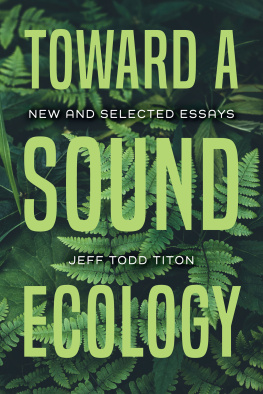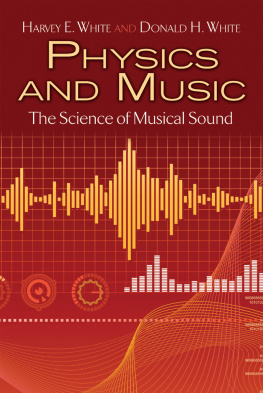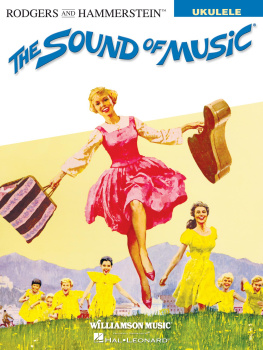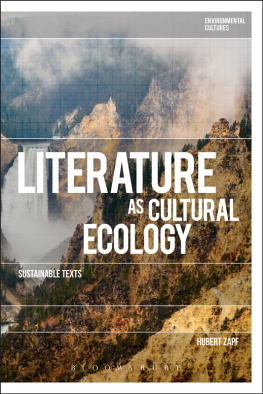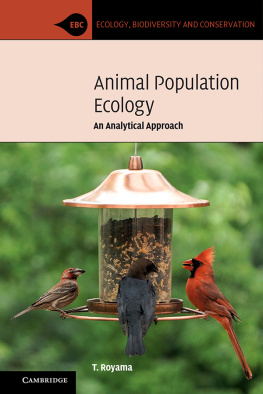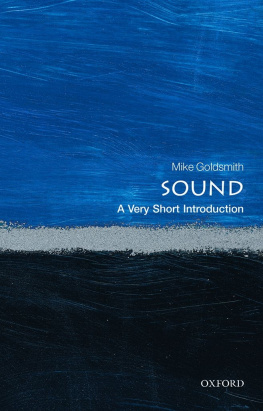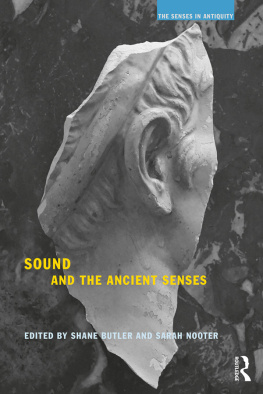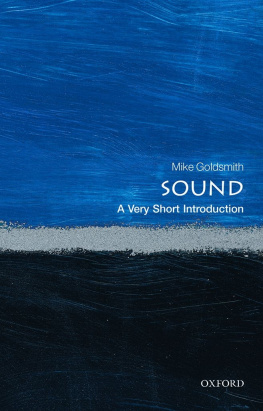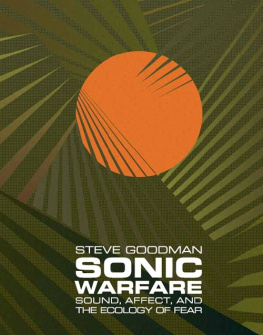Table of Contents
Guide
TOWARD A SOUND ECOLOGY
MUSIC, NATURE, PLACE
Sabine Feisst and Denise Von Glahn
TOWARD A
SOUND ECOLOGY
New and Selected Essays
Jeff Todd Titon
INDIANA UNIVERSITY PRESS
This book is a publication of
Indiana University Press
Office of Scholarly Publishing
Herman B Wells Library 350
1320 East 10th Street
Bloomington, Indiana 47405 USA
iupress.indiana.edu
2020 by Jeff Todd Titon
All rights reserved
No part of this book may be reproduced or utilized in any form or by any means, electronic or mechanical, including photocopying and recording, or by any information storage and retrieval system, without permission in writing from the publisher. The paper used in this publication meets the minimum requirements of the American National Standard for Information SciencesPermanence of Paper for Printed Library Materials, ANSI Z39.48-1992.
Manufactured in the United States of America
Cataloging information is available from the Library of Congress.
ISBN 978-0-253-04967-4 (hardback)
ISBN 978-0-253-04968-1 (paperback)
ISBN 978-0-253-05236-0 (ebook)
1 2 3 4 5 25 24 23 22 21 20
CONTENTS
I N WRITING THESE ESSAYS, I INCURRED MANY DEBTS along the way from friends, colleagues, and hosts to whom Im very grateful: Aaron Allen, Samuel Araujo, Robert Baron, Greg Barz, Max-Peter Baumann, Cherice Bock, Mia Boynton, Michael Bull, Bob Callahan, Bill Clements, Bill Coles, Tim Cooley, Elwood Cornett, Kathy Cornett, Marta Daniels, Dan Dennett, Mark DeVoto, Mark DeWitt, Beverley Diamond, Barry Dornfeld, Anu Dudley, Salwa El-Shawan, Veit Erlmann, Burt Feintuch, Dosh Fields, Jim Fields, Linda Fujie, Leslie Gay, Ken George, Henry Glassie, Darrell Grant, Steve Green, Klisala Harrison, Bess Hawes, Meredith Holmgren, Mary Hufford, Susan Hurley-Glowa, Patrick Hutchinson, Lewis Hyde, Ken Irby, Sam Jenkins, Loyal Jones, Alan Kagan, Enrique Leff, Albert Lord, Bill Lucas, Leo Marx, Dave McAllester, Judy McCulloh, Kiri Miller, Larry Millman, Bruno Nettl, Cameron Nickels, Wayne Newell, Barry OConnell, Marcia Ostashewski, Diana Parker, Dan Patterson, Mark Pedelty, Erkki Pekkila, Svanibor Pettan, Don Pratt, Shirley Pratt, Tom Rankin, Phil Rhodes, Jesper Rosenmeier, Suzanne Ryan, Oscar Schott, Tony Seeger, John Sherfey, Christopher Smith, Bob Stange, Jeff Summit, Barbara Tedlock, Dennis Tedlock, Tom Turino, Rory Turner, Denise Von Glahn, Franziska von Rosen, Thomas Walker, John Wallhausser, Jernej Weiss, Maryanne Wolf, and Andy Woolf. Those I mentioned will know why; to those Ive forgotten to name, my sincere apologies.
I owe an unrepayable debt to the educational institutions that have supported me over the years: my undergraduate alma mater, Amherst College; my graduate school alma mater, the University of Minnesota; Tufts University, where I taught from 1971 to 1986; and Brown University, where I directed the doctoral program in ethnomusicology from 1986 to 2013. Im grateful to several organizations for fellowships supporting my research, among them the National Endowment for the Humanities, the National Endowment for the Arts, and the Hutchins Center (formerly W. E. B. DuBois Institute) at Harvard. A number of colleges and universities graciously hosted me as a visiting professor, including East Tennessee State University, Indiana University, Berea College, and Amherst College.
I thank the following publishers for permission to reprint essays that first appeared in their books and journals: the University of Illinois Press for The Life Story, from the Journal of American Folklore, and for Text, from Eight Words for the Study of Expressive Culture, edited by Burt Feintuch; Oxford University Press for Knowing Fieldwork, from Shadows in the Field, edited by Gregory Barz and Timothy Cooley, and for Applied Ethnomusicology: A Descriptive and Historical Account and Sustainability, Resilience, Adaptive Management, and Applied Ethnomusicology, from The Oxford Handbook of Applied Ethnomusicology, edited by Svanibor Pettan and Jeff Todd Titon; Muzikoloski Zbornik (Musicological Annual, Slovenia) for Ethnomusicology as the Study of People Making Music; the world of music for The Real Thing: Tourism, Authenticity and Pilgrimage among the Old Regular Baptists at the 1997 Smithsonian Folklife Festival and for Music and Sustainability: An Ecological Viewpoint; the Smithsonian Institution for A Sound Commons for All Living Creatures, from Smithsonian Folkways Magazine; ABET (the Brazilian Ethnomusicology Society) for The Nature of Ecomusicology, from Msica e Cultura; Taylor and Francis for Thoreaus Ear, from Sound Studies; and Whole Terrain for The Sound of Climate Change. Full references to these essays may be found in the Selected List of Publications.
TOWARD A SOUND ECOLOGY
A NYONE WHOS BEEN PUBLISHED AND REVIEWED KNOWS THAT feeling of bewilderment when critics tell you what you really said, or meant to say, or should have said but didnt. Decades ago, a writer made a reputation from The Intentional Fallacy, an essay claiming that because authors never truly, deeply know what they intend, there isnt much point in reading for meaning in what they write about their own writing. The meanings, wrote William K. Wimsatt (1956, 320), lie hidden in the hieroglyph that the literary text itself makes; it is not in the authors life or beliefs nor how the author might interpret them. A few decades later, most critics were in agreement that a texts meaning varied depending on its interpretive communities, each operating according to its own rules, traditions, and consensus and each more or less valid in its own right. So readers are advised to take my interpretive remarks for what they may be worth, knowing theyll also discover their own patterns, like a figure in a Persian carpet, in the words of Henry James (1897, 33).
The figure in the carpet can be a helpful metaphor to think through the problems of coherence, discovered and imposed. James aficionados will recall that in his short story of that title, a well-known novelist, one Hugh Vereker, tells the storys narrator, a literary critic trying to rise in the world, that encompassing Verekers entire oeuvre there exists a pattern, a figure in the carpet, a general intention, the very string upon which the pearls are strung (ibid.). Vereker wont say what the figure is, though, and the rest of the story details the narrators failed quest to discover it, even though his good friend (another literary critic) and friends wife have, after years of effort, puzzled it out. The trouble is, they wontor cantreveal it, and all three go to their graves with the secret, leaving the narrator as baffled in the end as he was at the beginning. This reader of Jamess story does not doubt the existence of a figure in the carpet but comes to wonder about it: When it comes to be known, can it be put into words? And more, if it can be put into words, could the words possibly do it justice without diminishing its effect?
With those forewarnings in mind, I avoided looking for a figure in the carpet of my teaching, research, and writings until I was required to do so, the occasion being an invitation in 2014 to address one of my professional societies in answer to some questions based on the American Council of Learned Societies My Life in Learning premise. One of their questions was What are the key organizing concepts you have found consistently interesting in your progress and your career? In response, I told them that only in the past dozen or so years had an organizing concept seemed to reveal itself. I named it: the affective and connecting powers of sound, music being one manifestation of it among many. The figure in my carpet is not just sound but the connections among beings that sounds make: physical, communicative, technological, social, economic, and metaphysical. In some of the writings, it is close to the surface; in others, it is in a deeper layer.
Next page
